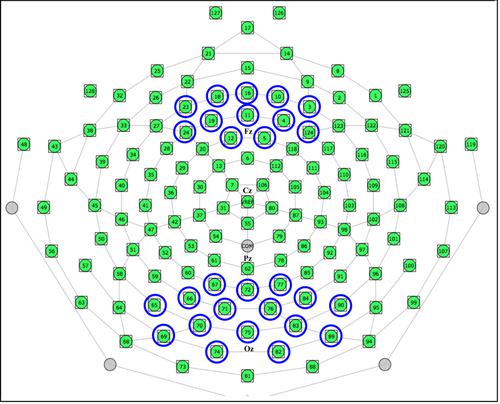当前位置:
X-MOL 学术
›
Ann. N. Y. Acad. Sci.
›
论文详情
Our official English website, www.x-mol.net, welcomes your
feedback! (Note: you will need to create a separate account there.)
Associations between red blood cell indices and iron status and neurocognitive function in young adults: Evidence from memory and executive function tests and event-related potentials
Annals of the New York Academy of Sciences ( IF 4.1 ) Pub Date : 2022-08-17 , DOI: 10.1111/nyas.14877 Sivan Raz 1, 2 , Ariel Koren 3, 4 , Carina Levin 3, 4
Annals of the New York Academy of Sciences ( IF 4.1 ) Pub Date : 2022-08-17 , DOI: 10.1111/nyas.14877 Sivan Raz 1, 2 , Ariel Koren 3, 4 , Carina Levin 3, 4
Affiliation

|
Cognitive impairment has been associated with anemia and iron deficiency; however, brain electrophysiological studies correlating red blood cell (RBC) indices and iron status to cognition in adulthood are scarce. We aimed to assess neurocognitive function in young adults of the general population and its correlation with RBC indices and iron status. Neurocognitive function was investigated using scalp-recorded event-related potentials (ERPs) within the context of a task-switching paradigm. ERPs and test performance were also compared across groups of “high”/“low” RBC and iron indices. Working memory was examined using the digit span test, in which mean corpuscular hemoglobin (MCH), mean corpuscular volume (MCV), and ferritin were found to be significant predictors of test performance, with higher MCH/MCV/ferritin being associated with better test scores. In the switching task, MCH, MCV, and ferritin were found to be significant predictors of task performance, with higher MCH/MCV/ferritin levels associated with a lower percentage of errors. Electrophysiological results showed that MCH and MCV were significant predictors of ERPs amplitude, with lower MCH/MCV levels associated with greater amplitude, which may reflect compensatory processes. P1, N1, P2, and P3 were greater for the low MCH/MCV groups. This is the first evidence of association between levels of MCH/MCV and brain function while engaged in an executive function task; possibly reflecting brain iron availability.
中文翻译:

年轻人红细胞指数与铁状态和神经认知功能之间的关联:来自记忆和执行功能测试以及事件相关电位的证据
认知障碍与贫血和缺铁有关;然而,将红细胞 (RBC) 指数和铁状态与成年期认知相关联的脑电生理学研究很少。我们的目的是评估一般人群中年轻人的神经认知功能及其与红细胞指数和铁状态的相关性。在任务切换范式的背景下,使用头皮记录的事件相关电位 (ERP) 研究了神经认知功能。还比较了“高”/“低”RBC 和铁指数组的 ERP 和测试性能。使用数字跨度测试检查工作记忆,其中发现平均红细胞血红蛋白 (MCH)、平均红细胞体积 (MCV) 和铁蛋白是测试表现的重要预测因子,较高的 MCH/MCV/铁蛋白与更好的测试分数相关。在切换任务、MCH、MCV 和铁蛋白被发现是任务表现的重要预测因子,较高的 MCH/MCV/铁蛋白水平与较低的错误百分比相关。电生理学结果表明,MCH 和 MCV 是 ERP 振幅的重要预测因子,较低的 MCH/MCV 水平与较大的振幅相关,这可能反映了代偿过程。对于低 MCH/MCV 组,P1、N1、P2 和 P3 更大。这是参与执行功能任务时 MCH/MCV 水平与大脑功能之间关联的第一个证据;可能反映了脑铁的可用性。
更新日期:2022-08-17
中文翻译:

年轻人红细胞指数与铁状态和神经认知功能之间的关联:来自记忆和执行功能测试以及事件相关电位的证据
认知障碍与贫血和缺铁有关;然而,将红细胞 (RBC) 指数和铁状态与成年期认知相关联的脑电生理学研究很少。我们的目的是评估一般人群中年轻人的神经认知功能及其与红细胞指数和铁状态的相关性。在任务切换范式的背景下,使用头皮记录的事件相关电位 (ERP) 研究了神经认知功能。还比较了“高”/“低”RBC 和铁指数组的 ERP 和测试性能。使用数字跨度测试检查工作记忆,其中发现平均红细胞血红蛋白 (MCH)、平均红细胞体积 (MCV) 和铁蛋白是测试表现的重要预测因子,较高的 MCH/MCV/铁蛋白与更好的测试分数相关。在切换任务、MCH、MCV 和铁蛋白被发现是任务表现的重要预测因子,较高的 MCH/MCV/铁蛋白水平与较低的错误百分比相关。电生理学结果表明,MCH 和 MCV 是 ERP 振幅的重要预测因子,较低的 MCH/MCV 水平与较大的振幅相关,这可能反映了代偿过程。对于低 MCH/MCV 组,P1、N1、P2 和 P3 更大。这是参与执行功能任务时 MCH/MCV 水平与大脑功能之间关联的第一个证据;可能反映了脑铁的可用性。











































 京公网安备 11010802027423号
京公网安备 11010802027423号